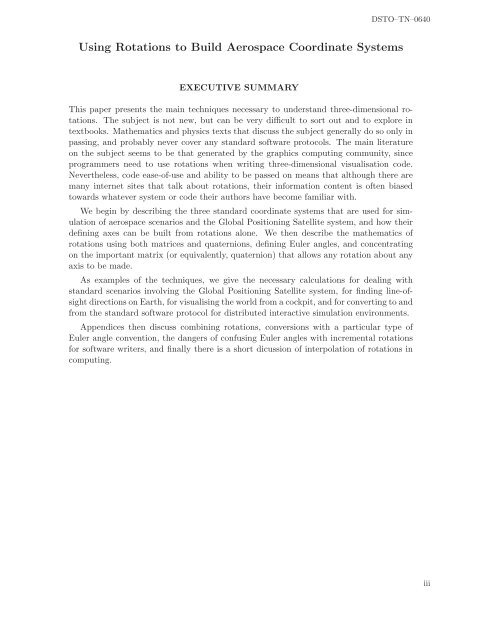Using Rotations to Build Aerospace Coordinate Systems - Defence ...
Using Rotations to Build Aerospace Coordinate Systems - Defence ...
Using Rotations to Build Aerospace Coordinate Systems - Defence ...
Create successful ePaper yourself
Turn your PDF publications into a flip-book with our unique Google optimized e-Paper software.
DSTO–TN–0640<strong>Using</strong> <strong>Rotations</strong> <strong>to</strong> <strong>Build</strong> <strong>Aerospace</strong> <strong>Coordinate</strong> <strong>Systems</strong>EXECUTIVE SUMMARYThis paper presents the main techniques necessary <strong>to</strong> understand three-dimensional rotations.The subject is not new, but can be very difficult <strong>to</strong> sort out and <strong>to</strong> explore intextbooks. Mathematics and physics texts that discuss the subject generally do so only inpassing, and probably never cover any standard software pro<strong>to</strong>cols. The main literatureon the subject seems <strong>to</strong> be that generated by the graphics computing community, sinceprogrammers need <strong>to</strong> use rotations when writing three-dimensional visualisation code.Nevertheless, code ease-of-use and ability <strong>to</strong> be passed on means that although there aremany internet sites that talk about rotations, their information content is often biased<strong>to</strong>wards whatever system or code their authors have become familiar with.We begin by describing the three standard coordinate systems that are used for simulationof aerospace scenarios and the Global Positioning Satellite system, and how theirdefining axes can be built from rotations alone. We then describe the mathematics ofrotations using both matrices and quaternions, defining Euler angles, and concentratingon the important matrix (or equivalently, quaternion) that allows any rotation about anyaxis <strong>to</strong> be made.As examples of the techniques, we give the necessary calculations for dealing withstandard scenarios involving the Global Positioning Satellite system, for finding line-ofsightdirections on Earth, for visualising the world from a cockpit, and for converting <strong>to</strong> andfrom the standard software pro<strong>to</strong>col for distributed interactive simulation environments.Appendices then discuss combining rotations, conversions with a particular type ofEuler angle convention, the dangers of confusing Euler angles with incremental rotationsfor software writers, and finally there is a short dicussion of interpolation of rotations incomputing.iii
















